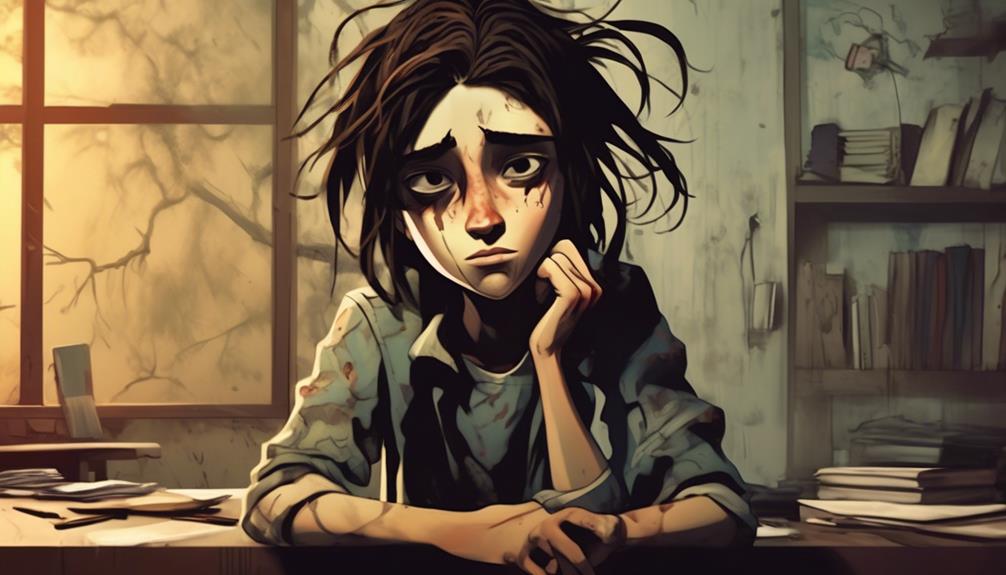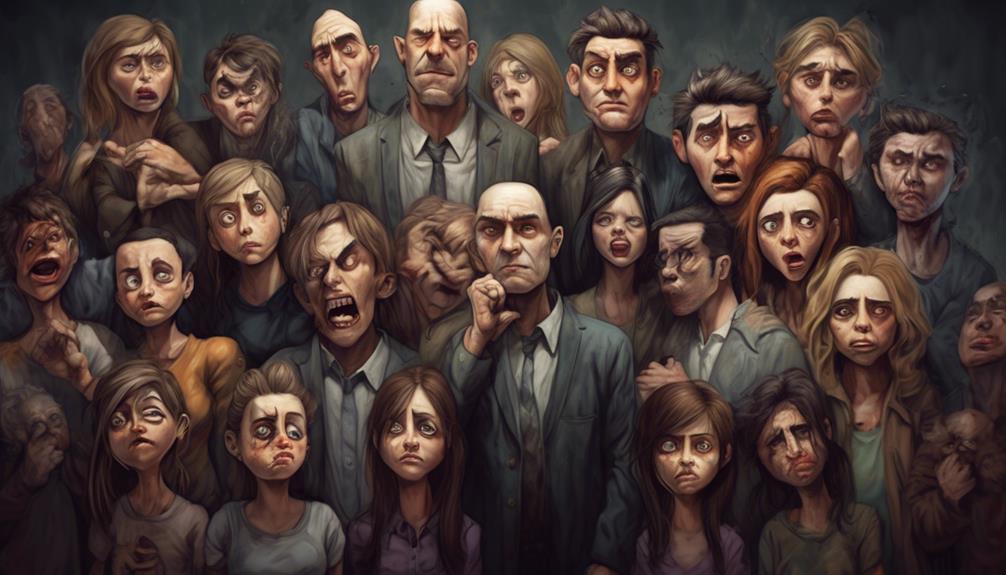When examining the portrayal of fictional characters who have been diagnosed with Borderline Personality Disorder, it is natural to question the authenticity and complexity of these representations. Nevertheless, the detailed portrayal of characters such as Harley Quinn, Anakin Skywalker, and Jessica Jones highlights the complex nuances and difficulties associated with BPD traits.
These characters offer a lens into the complexities of mental health struggles and the impact of trauma on individuals. By delving into their stories, we uncover a rich tapestry of emotions, behaviors, and relationships that invite us to contemplate the authenticity and significance of such portrayals in media.
Key Takeaways
- Media portrays BPD traits like intense emotions and fear of abandonment.
- Fictional characters reflect identity issues, emotional isolation, and past traumas.
- Characters exhibit impulsivity, unstable relationships, and emotional struggles in various forms.
- Portrayals in media contribute to awareness, empathy, and reduced stigma surrounding BPD.
Portrayal of BPD in Film
In films, the portrayal of Borderline Personality Disorder (BPD) often highlights characters grappling with intense emotions, impulsive actions, and a persistent fear of abandonment. These characters depicted in movies showcase a range of behaviors and struggles associated with BPD, such as self-destructive tendencies, challenges in forming stable relationships, and a fragile sense of self. The film portrayal of BPD delves into the complexities of identity issues, emotional isolation, and the profound impact of past traumas on the characters’ present-day lives.
Through the lens of cinema, audiences are offered a glimpse into the inner turmoil experienced by individuals with BPD, shedding light on their emotional dysregulation and coping mechanisms. The depiction of BPD in films varies in accuracy and depth, with some movies providing a nuanced exploration of the condition while others may resort to stereotypical portrayals. Nonetheless, these film depictions serve as a platform to raise awareness about BPD, reduce stigma surrounding mental health conditions, and foster a better understanding of the challenges faced by those living with the disorder.
BPD Depictions in TV Shows

Exploring how Borderline Personality Disorder (BPD) is portrayed in TV shows reveals a nuanced depiction of characters grappling with intense emotions and complex interpersonal challenges.
Key Points:
- ‘Crazy Ex-Girlfriend’: This show portrays characters with BPD traits like impulsiveness, self-loathing, and intense guilt, exemplified through the character of Rebecca Bunch. The series delves into her struggles with relationships and emotional turmoil, shedding light on the challenges faced by individuals with BPD.
- ‘Homeland’: Characters in this series exhibit behaviors associated with BPD, showcasing struggles with emotional intensity and identity issues. These portrayals provide insight into the complexities of living with the disorder and how it impacts one’s relationships and sense of self.
- ‘Sherlock’: The character Jim Moriarty in ‘Sherlock’ displays BPD traits such as impulsivity and unpredictable behavior. Through Moriarty’s character, the show explores the volatile nature of individuals with BPD and the impact it has on their interactions with others.
Notable Characters in Literature
Delving into the realm of literature reveals a myriad of notable characters exemplifying traits associated with Borderline Personality Disorder (BPD). Characters like Annie Wilkes from Stephen King’s ‘Misery’ showcase BPD traits through their obsessive and volatile behavior towards others, particularly in the context of abandonment and unstable relationships. Kathryn Merteuil in ‘Cruel Intentions’ embodies manipulation, impulsivity, and intense emotions, reflecting BPD characteristics such as intense guilt magnified and struggles with dependency issues. These relatable characters can validate the experiences of individuals who also struggle with the difficulties of dealing with intense emotions and unstable relationships.
In a similar vein, characters like Norman Bates from ‘Psycho’ and Amanda Young from the ‘Saw’ franchise exhibit traits of identity disturbance and self-destructive tendencies, which are common in individuals with BPD. Through their stories, readers often find a reflection of the challenges faced by those who feel emotions intensely and have a difficult time navigating their sense of self and relationships. The complexities of these characters offer a deeper understanding of the impact of BPD traits in literature.
Animated Characters With BPD

Notable characters in literature demonstrate traits associated with Borderline Personality Disorder (BPD); shifting our focus to animated characters, we encounter individuals like Harley Quinn from various DC animated series and movies, who embody BPD characteristics in compelling ways.
Animated Characters With BPD:
- Harley Quinn: Known for her unpredictable behavior, intense emotions, and identity struggles, Harley Quinn exemplifies various BPD traits like impulsivity and unstable relationships in animated portrayals.
- Raven: In the Teen Titans series, Raven grapples with emotional isolation and struggles to control her intense feelings, reflecting common BPD challenges in an animated context.
- Rocket: Rocket from Guardians of the Galaxy showcases emotional depth and complexity, often dealing with abandonment issues and a fear of intimacy, traits common in individuals with BPD.
These animated characters provide viewers with nuanced depictions of individuals grappling with BPD traits, adding layers of complexity to their narratives and inviting deeper exploration of mental health themes in animated storytelling.
Impactful BPD Portrayals in Comics
In examining impactful portrayals of Borderline Personality Disorder (BPD) in comics, characters like Harley Quinn and Darth Vader stand out for their nuanced depiction of BPD traits and their influence on character development.
Harley Quinn, known for her fear of abandonment and impulsivity, embodies the erratic behaviors often associated with BPD. Her complex relationship with the Joker in various comic storylines showcases the intense emotions and identity struggles typical of individuals with BPD.
On the other hand, Darth Vader’s journey from Anakin Skywalker to the Dark Lord reflects a profound exploration of BPD themes, such as inner turmoil, emotional instability, and struggles with self-identity.
These portrayals not only contribute to the depth and richness of these characters but also serve to raise awareness and reduce stigma surrounding BPD in popular culture. By showcasing these characters’ struggles with mental health, comics play a crucial role in fostering understanding and empathy towards individuals dealing with similar challenges in real life.
Frequently Asked Questions
Which Fictional Character Has Borderline Personality Disorder?
We can identify fictional characters with borderline personality disorder traits by examining their intense emotions, fear of abandonment, impulsiveness, manipulative behavior, erratic actions, lack of empathy, identity struggles, and emotional instability.
These traits are often displayed in characters like Darth Vader, Harley Quinn, Kathryn Merteuil, Patrick Bateman, and Norman Bates.
Identifying such traits in characters helps us understand how borderline personality disorder manifests in fictional narratives.
Who Famous Has Borderline Personality Disorder?
We’ve delved into famous figures who openly shared their struggles with Borderline Personality Disorder (BPD), such as Pete Davidson and Marsha Linehan. Speculated cases like Marilyn Monroe and Amy Winehouse also draw attention.
These individuals shed light on the realities of living with BPD, challenging stereotypes and fostering understanding. By examining their experiences, we gain insight into the diverse manifestations of this complex disorder among public figures.
Why Is BPD Life Expectancy 27?
The assertion that BPD life expectancy is 27 stems from a study examining mortality rates among individuals with BPD. Factors like suicide, self-harm, and other health issues contribute to this statistic. However, the accuracy of this figure is debated in the mental health field.
Various factors such as early trauma, comorbid conditions, and access to care influence the health outcomes and longevity of those with BPD. It’s essential to approach this topic with sensitivity and recognize individual differences in experiences.
What Superhero Has Borderline Personality Disorder?
Superheroes like Deadpool, Tony Stark/Iron Man, Jessica Jones, and Wolverine have been analyzed for potential traits of borderline personality disorder due to their impulsive actions and emotional struggles. These characters display complexities that resonate with traits associated with BPD.
While not explicitly diagnosed within the stories, their behaviors and challenges align with characteristics commonly linked to borderline personality disorder. Their portrayals invite discussions about mental health representation in popular media.
Conclusion
In exploring fictional characters with Borderline Personality Disorder, we uncover a rich tapestry of diverse personalities and experiences. One fascinating statistic reveals that over 14 million American adults are affected by BPD, highlighting the prevalence and importance of accurate representation in media.
Through these characters, we gain insight into the complexities of mental health struggles and the impact of trauma, fostering greater awareness and understanding of BPD in society.
Paul is a storyteller at heart, sharing narratives illuminating the lived experiences of those with BPD. His work encompasses a range of topics, from personal journeys to the challenges and triumphs faced by individuals navigating life with BPD. Paul’s authentic and engaging writing style invites readers into the world of BPD, promoting awareness and empathy.










